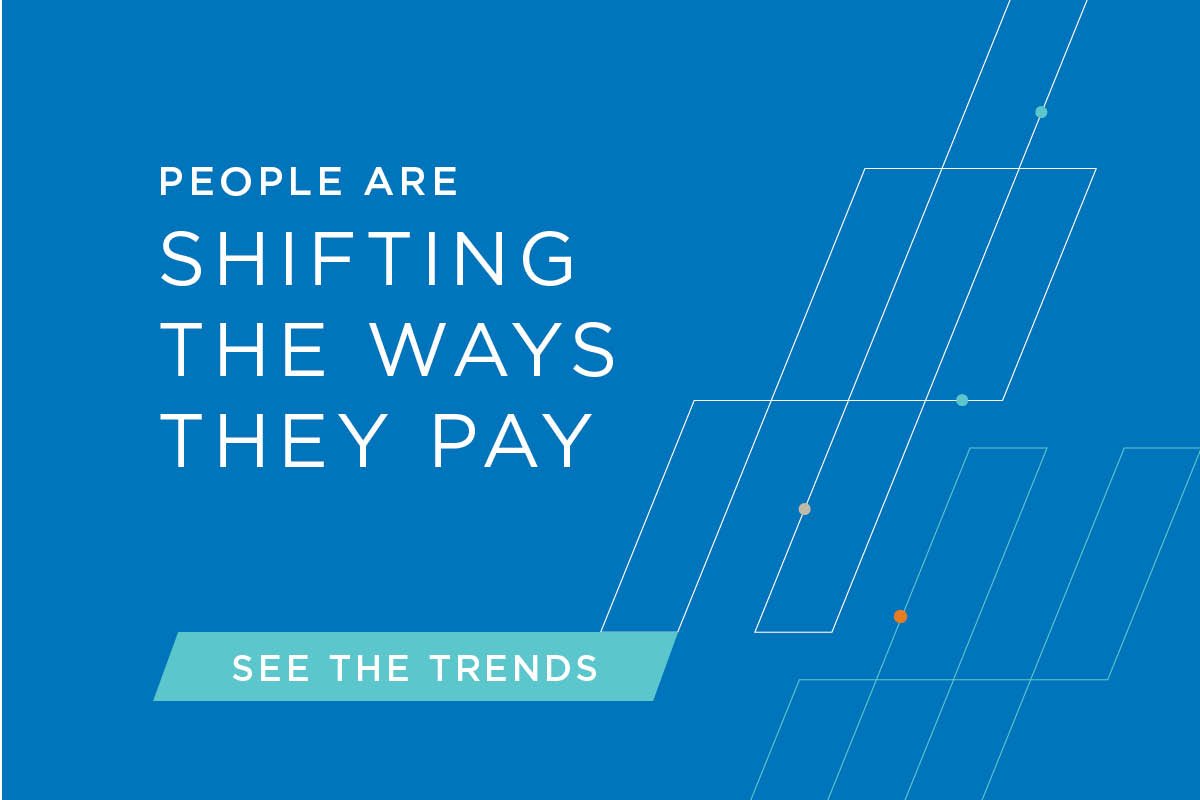Cash is no longer king.
While it remains a reliable secondary payment option, cash has declined in consumers’ payment preference, going from 52% of consumers in 2019 to 44% in 2021, according to a Mintel report. What’s on top? Credit cards. Sixty-one percent of American adults rank them their top payment choice. However, credit card popularity declines as younger generations move toward alternative payment methods.
The pandemic accelerated the transition to a cashless environment, as more consumers used multiple cards to maximize benefits and store their card information in mobile wallets. At the same time, the pandemic increased the adoption of mobile payment alternatives, including peer-to-peer payment (P2P) apps such as Venmo® and Zelle®, among millennials and Gen Z.1
Payment pivot #1: Checks vs. P2P – alternative channel, not a replacement
Checks have been steadily declining over the last decade. In contrast, P2P apps have skyrocketed over the previous three years. However, this does not mean they are replacing checks.
Instead, mobile payments are used for smaller transactions, while checks are written for more significant amounts. The proof: the average check transaction value is over $2,000, up by 5%, according to the Federal Reserve.2 People write checks for charitable contributions, rent or mortgage, large purchases and tax payments.
Financial institutions should position checks for larger transactions and P2P apps as an alternative to check writing for smaller payments.
Payment pivot #2: Digital payment adoption is skyrocketing
It is not surprising that Gen Z and millennials are the primary adopters of digital wallets. What is surprising is that older generations are adopting them, too. When asked, consumers from each older generation confirmed that they have used a digital wallet in the past year, with Gen X at 65%, 33% for Baby Boomers and 17% for the Silent Generation.3
Two-thirds of respondents cite convenience as the reason they use digital wallets4.But each generation defines convenience differently.
Banks and credit unions need to offer mobile banking as it has already outpaced online banking. And they must ensure their systems integrate seamlessly with P2P apps for easy fund transfer, cash in and cash out between accounts.
Financial institutions should also encourage their customers to connect their cards to mobile wallets and position P2P apps for smaller everyday payments and as a replacement for cash.
Payment pivot #3: Card issuers are offering more earning options
As the use of credit cards grows, companies have added more ways to earn for their rewards cards, such as cashback, bonus points for everyday purchases, APR reduction for paying on time, and incentive cash or points for signing up and reaching a spending threshold. Top travel card issuers have shifted to adding rewards for everyday purchases.
For cash-strapped consumers, this was one way of saving money or earning extra cash. For affluent consumers who could not travel during the pandemic, these flexible rewards offered alternative incentives to keep them using their cards.
Card issuers could not rescind these benefits. Sixty-three percent of affluent consumers carrying multiple credit cards with annual fees said they would rather pay for those fees than lose these benefits.5
Another trend is the increase in the use of direct mail by credit card companies, which spent $2.1 billion on direct mail credit card offers in 2021.6 And it is not just direct mail. Card issuers are tapping connected TV ads to promote their offers, given that 86% of households now have at least one streaming service.
Payment pivot #4: Gen Z leads the adoption of alternative payment tools
One thing that distinguishes the Gen Z generation is its avoidance of credit cards.
Gen Z prefers to use digital wallets and P2P apps to pay peers and for services. And if these payment options are not accepted, they will use cash as a backup rather than a credit card. This cost-conscious generation is wary of taking on debt and would rather pay cash to avoid paying card processing fees or other fees.7
Another significant trend among Gen Z is using Buy Now Pay Later (BNPL) solutions instead of a credit card to meet their credit needs. BNPL plans are attractive because they usually are interest-free or fee-free if paid on time. Around 43% of Americans have used BNPL to finance a purchase. Some 55% of Gen Z use BNPL to purchase higher-ticket items they otherwise could not afford to pay for outright.
BNPL is now the fastest-growing alternative payment. However, there is also a danger of overspending and getting into debt. Forty-two percent of BNPL users have made late payments. What is also alarming is that Gen Z is also the most likely to incur a late fee and have multiple BNPL payments a month, according to Motley Fool’s The Ascent.
Financial institutions may not be able to curb the BNPL trend. However, it can encourage Gen Z, who can pay BNPL payments on time to use a credit card instead. At least, this allows them to build a credit history they wouldn’t be able to do with BNPL.
- Faverio Michelle, “More American are joining the “cashless” economy”, Pew Research, October 5, 2022
- Federal Reserve, March 2022
- Finder Digital Wallet Adoption survey, April 2021
- Ibid.
- S&P Capital IQ, April 2022
- Mintel Research, Comperemedia, 2022
- Logica, “Gen Z Is Buying See How They Pay Report,” 2022
